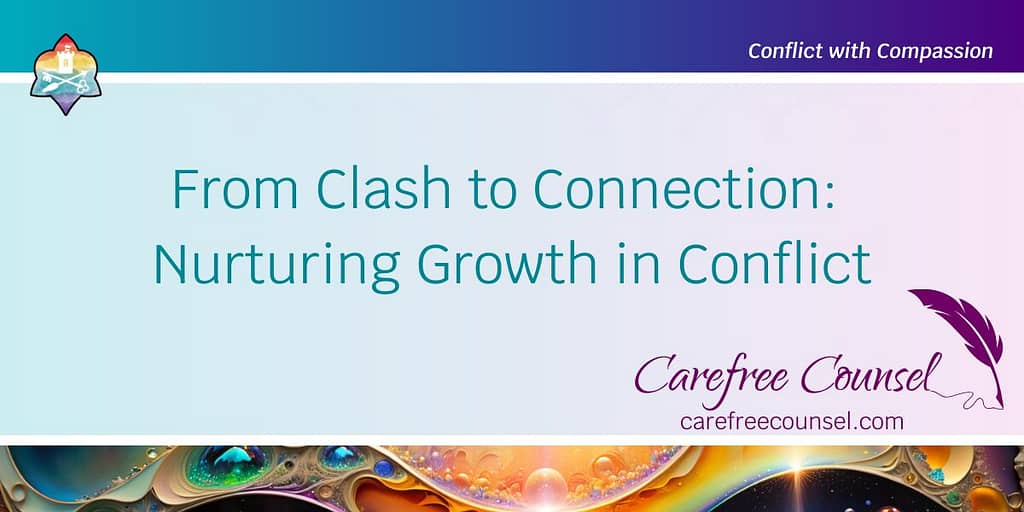
Recently, I wrote about how to flip the script on our perception of risk, taking it from a threat to an opportunity. Conflict is normally associated with threat, but did you know it can also provide wonderful opportunities? In this article, I’m talking about the kind of conflict that is not really dangerous – the household argument, the lovers’ quarrel, the bitchy customer, the backstabbing friend. If the kind of conflict you’re dealing with is actually capable of seriously harming you or someone else, don’t try to deal with it alone. Get yourself to a safe place and reach out for professional help. Everyone else, read on.
Conflict can be a force for creative change
Conflict is cathartic – it often focuses lots of energy on a situation that is ripe for change. It stirs up the status quo. Conflict usually arises because we care deeply about something and there is a clash between our perspective on that thing and someone else’s perspective. If we’re able to open our minds and stay curious during the conflict, we can learn a lot about ourselves, the other person and the possibilities for growth and healing in the situation.
Here are three practical tips to get creative with, next time you find yourself in a situation of conflict.
Acknowledge and manage the role of anger
Anger is our ally. This is not a sentiment that sits easily with most women. We’re taught that nice girls don’t get angry. “If you haven’t got anything nice to say, don’t say anything at all.” Bottle it up – then watch it come pouring out in a torrent of dragon-mum vitriol at your loved ones when you are under stress, and pack your bags for the obligatory guilt trip. We are not taught how to deal with anger, whether it is our own or other people’s.
A good place to start when trying to get a handle on why you fly off the handle is understanding anger’s role. Anger tries to protect us, to keep us safe. It often arises when we feel threatened or attacked, powerless or frustrated. We can’t get rid of anger or suppress it, but we can learn ways to use its high energy in a constructive manner.
It’s also important to recognise that there is no “one-size-fits-all” model of anger. Different people may show their anger in different ways depending on the situation they are in and the people surrounding them. You might scream, swear and throw darts (or coffee mugs) at a picture of the person who has upset you when you are in private, while in public you simply seethe with suppressed volcanic fury, gnawing ulcerous holes through your stomach lining. You might try to make the other person uncomfortable with needling sarcasm, or your imagination might work overtime plotting the perfect, devastating downfall for your nemesis. The problem is that none of these expressions of anger are productive, or particularly healthy.
To start channeling our anger (and that of others) into a force for creative change, we need to dig a little bit to find the source. What emotion lies underneath the anger? Anger is a fiery emotion, but it needs fuel to feed the flame. Identifying the secondary emotion simmering under the surface is the key to the whole conflagration. From my experience, the vast majority of the time, that secondary emotion will be fear. At some level, the angry person’s subconscious is convinced that its existence is threatened and it must fight tooth and nail for survival. Acknowledging this (even internally) can act like a soggy piece of damp cardboard, sending up a smoke signal of empathy to break the hold of a tantrum and turn it into a treaty-talk.
Of course, when we are the ones who are angry, or when someone else’s anger is triggering our own fight or flight response, having the presence of mind to step outside the danger zone and assess the situation calmly is easier said than done. That is where tools like hooponopono and EFT can help, soothing our subconscious and helping us recover sufficient presence of mind to respond rather than react.
Take responsibility
“Whaaaaaat!?! It’s not my fault. It’s never my fault. It’s all THEM.” (Surely mine is not the only inner voice that screeches so shrilly that all the crystal in the house shudders?)
I’ve got you, sister. Take a deep breath and pull your big girl pants on. You’re going to need them for this next step.
Next time you are in a conflict situation, take a little time to consider the situation as though you were 100% responsible for the situation. (I know, I know, it’s not true – so just use your imagination.) Your aim here is not to give your inner critic a free pass to beat you up and bully you. What we are seeking is understanding. What are the triggers at play here? What does the dinosaur biting your backside look like – and how have you been pushing the other person’s buttons in your bid to escape from it?
The more we practice doing this, the easier it gets (promise) and it opens up a new door for us. Our newfound understanding helps us to choose to interrupt these patterns of behaviour before they escalate into the war-of-all-against-all. We gain the ability to notice when our autopilot self-defence system is leaping into action, and choose a different, conscious pattern that is aligned with our values and our vision for this relationship.
Think for a moment – what would it be like if you were prepared to change yourself – without waiting for the other person to change first, or even for them to stop doing that annoying, hurtful thing they do so well? How empowering would that be? Can you be big enough to make the commitment not to play this game any more? You might be surprised by how quickly a conflict deescalates when one side puts down their weapons and starts turning the other cheek.
I need to be clear here, that I am not talking about a passive-aggressive “F-you, I’m not fighting any more, I am going to go sulk in silence.” That’s still fighting, whether it looks like it or not. Instead, try starting with an honest apology for your part in the conflict. Apologise for any words or actions you think the other person might perceive as harmful. When it comes to apologies, timing is everything, so pick your moment carefully to be sincerely disarming. Don’t dissemble and try to make excuses, and don’t get it into a tit-for-tat contest. Can you admit your contribution without trying to justify it, explain how the other person is equally to blame, or mentioning what has been done to wrong you? It’s not easy.
If you really REALLY want to stop an argument, the most effective way is simply to shut your mouth and open your ears. Try to separate what they are saying from how they are saying it. When you are able to truly hear what it is important to the other person, you can summarise and reframe their words to show that you get where they are coming from, and then respond intentionally and with caring. Bring all of your warm curiousity to the table and make it clear to them that you value the relationship, even if you disagree with their perspective on the situation. Show them that you are ready to let go of the past and focus on the future by identifying an external problem that you can work together to solve.
Talk it out
In order to identify new possibilities and pursue positive change, you need to enter into the world of the unknown. That can be scary, and we have already seen how fear can fuel anger, so be prepared for new eruptions and don’t let them derail the peace train. Think about your goal for this conversation. Are you hoping to repair something that is broken? Do you need to reconstruct a damaged relationship? Are there wounds that need healing? When you have clarity about what you want to achieve – both in the physical world and on a metaphysical, interpersonal level, you will find it easier to stay on track.
One of the best places to begin is with appreciation. Is there anything that this conflict has dredged up that you can be grateful for? Can you share with the other person something that you love about them? What is important to you in the relationship that you are keen to hang on to? Shifting a conflict situation into the vibration of gratitude completely changes the dynamic. How else can you remind yourselves that you are two caring people who are discussing something that really matters to each of you? If it wasn’t important or you didn’t care, you wouldn’t be putting yourselves (and each other) through this suffering. Try and zero in on those shared values, those things you both want to preserve. Find your common ground and be thankful for it.
Talking about feelings can risk reigniting the conflict, but it is also an important element of feeling heard. Here’s a phrase used in non-violent communication that has often proved effective: “I feel … when you … because …” When you are clearly talking about what is true for you, and giving an explanation for how it affects you, it can help the other person put themselves in your shoes, allowing you to express your emotion and have it received with empathy rather than shame and blame.
At the heart of all conflict, there is almost always some kind of request. Something is wanted – usually something so deep and dear that it is difficult to put into words, so everything else gets said except what is truly desired. There’s a game I like to play when watching the kind of dramatic conflict that drives most movies – “name the need”. If you play this game, you will quickly realise that it has almost nothing to do with what is being said, but given half a chance, intuition is awesome at reading between the lines. Can you tune in to what the other person actually wants from you? Or for a real challenge, can you courageously state what you need, in a way that is not threatening for the other person? Where needs appear to be mutually incompatible, don’t give up. Acknowledge that both of you have a right to satisfaction and try asking “how can we meet your need for A, while meeting my need for B at the same time?” Staying open-minded and considering all possible solutions can result in surprising and wonderful compromises.
How I can help
Sometimes, in order to prepare to enter into a conflict situation consciously and defuse your inner triggers, it can help to talk through the issues with a neutral third party and get some conflict coaching. If this sounds like what you need, book a Conflict with Compassion consultation.

